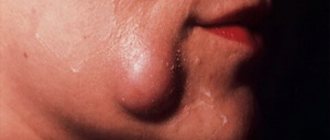Gums and teeth
Everyone knows that teeth are the main characters in the process of chewing and grinding food. According to their roles, teeth in a person’s mouth are divided into types:
- Incisors – the front 4 teeth, play the role of biting off the largest pieces.
- Fangs - their role is to break food and separate it into pieces; they are also called “eye teeth”.
- Small and large molars play the role of chewing and grinding food.
People eat food of different origins, both plant and animal. On this basis, it was concluded that people are omnivorous creatures.
This is possible due to the arrangement of the teeth and the structure of the oral cavity, which makes humans fundamentally different from animals.
All teeth have the same structure: a soft core, dentin. The core consists of blood vessels and nerves, and the hard substance (bone) is dentin. The main function of this substance is to protect teeth from microdamage. To do this, it is “painted” with enamel, which feels absolutely nothing. In addition, enamel has no equal in strength in the human body. It consists of an alloy of minerals (phosphorus and calcium salts) saturated with organic substances. The highest concentration of calcium is observed in dentin, where nerve fibers are contained.
Oral mucosa: what to pay attention to
Regular dental examinations are an important part of the prevention of not only dental and periodontal diseases, but also pathologies of the oral mucosa. They make it possible to detect cancer, leukoplakia, stomatitis and other dangerous diseases in the early stages.
Inspection algorithm
The American Dental Association recommends that your oral examination include the following steps:
- a thorough visual examination of the lips, buccal mucosa, gums, anterior part of the tongue, floor of the mouth and palate;
- examination of the throat (pharynx), including tonsils, root of the tongue;
- palpation of the jaw and neck to detect nodes, tumors, any abnormalities or abnormalities.
This procedure allows you to timely identify foci of pathological processes in the oral mucosa (OM), including erosion, ulcers, compactions, and also assess the condition of the lymph nodes.
Russian specialists adhere to a similar inspection algorithm. He suggests that the dentist should pay attention to any visible abnormalities in the structure of the face, nose, cheeks or chin. Pathological changes, taking into account their localization, are recorded using special codes. Thus, ulcerations of the mucous membranes, wounds, tissue erosions, cracks, enlarged lymph nodes and any other lesions are necessarily noted.
Oral diseases
The most common symptoms of stomatitis encountered in dental practice. Acute herpetic stomatitis accounts for 85% of all diseases of the oral mucosa; chronic recurrent aphthous stomatitis is also common [1].
Aphthous stomatitis is considered a diagnostic feature of aphthous stomatitis - oval ulcerations on the oral mucosa with clear edges, with a diameter of 3-12 mm or more, surrounded by a halo of hyperemia. Herpetic stomatitis is characterized by blistering rashes not only on the surface of the mucous membrane, but also on the lips and skin around the mouth.
Data from multicenter studies in different countries of the world also indicate a high level of prevalence of other oral diseases: leukoplakia, candidiasis, lichen planus.
Leukoplakia is characterized by the presence of foci of keratosis in the form of whitish thickenings on the oral mucosa and the red border of the lips. With candidiasis, spots of white plaque with a cheesy consistency form on the mucous membrane, which are easily scraped off with a spatula. With secondary bacterial infection and erosion, the plaque may acquire a brownish tint.
The most common sign of oral lichen planus is also gray-white spots. They appear on the inner surfaces of the cheeks, tongue and gums. Due to the similarity of these manifestations with the symptoms of other diseases, in particular leukoplakia, visual diagnosis can be difficult.
Unfortunately, in recent years the number of cases of oral cancer has been increasing. The World Dental Federation attributes this to widespread smoking and alcohol consumption. Therefore, early diagnosis of cancer of the oral mucosa is becoming increasingly important. It is precisely this that makes it possible to identify precancerous and cancerous states of cells at stages when treatment can be anatomically gentle.
Experts advise paying attention to the following signs, which may be symptoms of oral cancer:
- long-term non-healing wound or irritation;
- red or white spots;
- sensation of pain, numbness, sensitive areas in the mouth or on the surface of the lips;
- tumors, thickening, roughness, erosion and other changes;
- difficulty chewing, swallowing, speaking, or moving the tongue or jaw.
The number of visits to dentists by Russians is approximately 15 million per year [2]. This figure is higher than any other medical specialty. Therefore, the doctor’s compliance with the external examination algorithm, thoroughness and accuracy during its implementation are the key to the success of early detection of many dangerous diseases of the oral cavity.
List of sources
[1] Zarkumova A.E. Structure of morbidity of the oral mucosa // Bulletin of KazNMU. 2022. No. 3. URL: https://cyberleninka.ru/article/n/struktura-zabolevaemosti-slizistoy-obolochki-polosti-rta (date of access: 05/22/2020).
[2] Astakhov P. Chief dentist of the Ministry of Health: mortality in the dentist’s chair is below 0.001% // RT, June 7, 2022. URL: https://russian.rt.com/russia/news/397438-glavnyi-stomatolog-minzdrav-smertnost (access date: 05/22/2020).
Language structure
The human tongue is a soft pink colored muscle mass on which taste buds are located. At the very top of the tongue, and along its edges, there are papillae, which are responsible for the taste of everything that comes into our mouth. It is no secret that the mouth is the first point where the initial processing of food and the adsorption of microorganisms and harmful substances begins. The tongue takes on the most important role here, accumulating on its surface all the harmful substances that form a coating known to everyone. It is imperative, for preventive purposes, to clean your tongue of plaque, which will get rid of the unpleasant odor and possible infections. At the root of the tongue, there are no papillae, there are tonsils. Which play an important role in protecting the human body, standing in the way of microbes, they do not allow them to penetrate inside.
Sky structure
The part of the oral cavity that is located on top is called the palate. The palate is made up of 2 components, hard and soft. The mucous membrane covers both parts, passing through the hard palate to the soft palate, it gradually turns into gums. The front side of the palate forms rudimentary formations (palatine alveoli), humans do not fully use them, but animals, on the contrary, use them to eat food. The palate has another role besides forming the upper part of the mouth; it is a barrier between the nose and nasopharynx. A kind of barrier wall is a small tongue that blocks access to the nasopharynx during the digestion process.
Structure of the mucous membrane
The entire human oral cavity is covered with a mucous membrane, which has a distinctive feature, regenerative ability. The mucous membrane protects the oral cavity from environmental influences. Chemical, mechanical, temperature factors cannot influence it. The structure of the mucous membrane is simple; in the lower part of the mouth - on the cheeks and lips, it forms folds; in the upper part - attached to the bones. The main roles of the mucous membrane:
- The protective role is unpleasant, but it is a fact that many viruses and bacteria accumulate in the human mouth. The mucous membrane retains, prevents reproduction and removes all harmful microorganisms from the oral cavity.
- Sensitive role - Due to the presence on its surface of many receptors responsible for sensations (taste, pain, temperature), it signals all the events that accompany food intake.
- Absorption role – Thanks to this ability, we are able to take medications “under the tongue”. The mucous membrane perfectly absorbs protein and mineral compounds.
The structure of the oral cavity and the functions of its structures
The mouth, or oral cavity, is made up of many structures that work together to help us breathe, speak, smile, eat, and digest food. Once you become familiar with these anatomical structures and how they affect your overall health, you will understand why proper and regular oral care is so important. Listed below are the elements that make up the human oral cavity and the functions they perform.
Lips and cheeks
The basis of the lips and cheeks are muscles that allow us not only to kiss, but also to express a lot of different emotions - from joy to sadness. Through open lips, air enters the mouth and then into the lungs, allowing us to breathe. The muscles of the lips and cheeks help us speak. In addition, while eating, they retain food and saliva in the mouth. Finally, these strong muscles also influence the position of our teeth.
Language
The tongue is a powerful muscle that helps us chew, swallow, speak and taste food. Thanks to the taste buds, or taste receptors, located in the tongue (as defined in the Atlas of Human Anatomy), we can enjoy the taste of food. In total, in the oral cavity - on the tongue, palate, mucous membrane of the pharynx - there are up to 2500 such receptors, with the help of which we distinguish sweet from salty, bitter from sour.
Teeth, gums and alveolar bone
Teeth have a crown covered with hard enamel and roots that are held in the jaw bone. The stability of the teeth is ensured by the alveolar bone, periodontal ligament and gums surrounding the roots, which also protects the roots of the tooth from caries. The main function of teeth is to crush and grind food so that it can be digested in the stomach. In addition, teeth support the soft tissues of the face, giving them a certain shape, help us pronounce certain sounds and make our smile attractive.
Salivary glands
Humans have six glands that produce a clear liquid called saliva. Saliva is mostly water, but also contains substances that break down food so it can be digested. In addition, saliva moistens the mouth, making it easier to speak, chew and swallow. It continually washes away bacteria from your teeth and gums, helping prevent the development of tooth decay and periodontitis. The minerals and proteins contained in saliva play an important role in protecting the enamel from carious lesions. According to information presented on the MedWeb information portal, the human body produces up to two liters of saliva per day.
Temporomandibular joint
The ability to open and close the mouth, move the lower jaw forward, backward and side to side, as well as chew, speak and swallow, we owe to the work of the temporomandibular joints (TMJ). As dentists explain, these extremely complex paired joints, located on the right and left sides of the face, are set in motion by a whole group of muscles and ligaments. The slightest desynchronization of these joints—for example, due to arthritis or teeth grinding—can cause facial pain, difficulty chewing food, and other jaw mobility problems.
Maintaining oral health
To keep all oral structures healthy, brush your teeth twice daily using fluoride toothpaste, a soft-bristled brush, mouthwash, and clean between your teeth with dental floss. Regular cleaning of the tongue with a special pad on a toothbrush or scraper will help remove plaque accumulated on its surface. Using an antimicrobial mouth rinse will reduce the number of pathogenic bacteria that cause bad breath. It is equally important to give up tobacco and limit the consumption of sugars and other carbohydrates that provoke the development of caries: this will have a beneficial effect on the condition of the body as a whole.
Don't forget to regularly undergo preventive examinations and visit a hygienist for professional teeth cleaning, which allows you to remove tartar and plaque from areas of the dentition that are inaccessible to a brush. By carefully examining the oral cavity, the dentist will also be able to notice in time the slightest signs of cancer, the early diagnosis of which is of paramount importance.
The beauty of teeth is, of course, important, but the good condition and performance of all structures of the oral cavity is even more important, because this is the key to not only dental, but also the general health of each of us.









